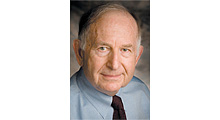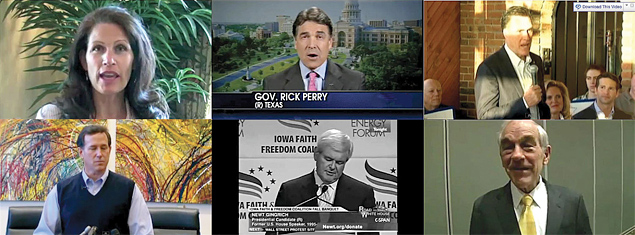Shining a Light on Politics

The majority of the time in this column we are discussing good lighting. What about "bad" lighting? It has occurred to me that much would be gained if we were to illustrate examples of bad lighting. A casual Internet search through the intensive media coverage of the Iowa presidential caucus provided me with plenty of examples.
Bad lighting can cover a very broad field, but I have limited my choice to the most important topic: the lighting of people. We shall use the straightforward definition of bad lighting as proposed by Gerald Millerson in his definitive "Lighting for TV and Film"—lighting that makes people "unattractive."
Simple enough. In order to be as politically agnostic as possible and to show no bias toward any candidate, there is only one example shown for six of the candidates.
LADIES FIRST
The close-up of Michele Bachmann is quite tight and, as is true for its size, would require a very deft and sensitive touch to the lighting. Instead, she has been placed in an extremely unattractive lighting situation—a cross light with disturbing highlights of portions of her face.
In my opinion, the starting point for finding the most flattering direction of a face light (for women, particularly) is always on the center line of camera and subject, and with not too much elevation. Initially, it doesn't matter whether the light is hard or soft, but that initial direction is probably going to yield an attractive result.
Of course, the example has one additional flaw: a back light, which might have been OK if it were not for the fact that it has a rather blue tint. (Homework assignment: Can you guess its source? daylight? HMI?) It has another shortcoming that deserves a demerit for bad practice—a highlight on Bachmann's cheek as well as on her nose.
A STUDIO SETUP
Finding bad lighting examples of location shooting is actually simple when the realities of actual conditions are considered, realities best described as "guerilla" shooting.
My second example has no such excuse as it is a studio setup. It is a perfect example of the very prevalent use of two cross-key lights—one light of equal intensity on each side of the camera. Supposedly, this is a very "safe" approach. This very common method is right up there on the Bad Lighting list.
In my example, Rick Perry displays two symmetrical, unbecoming cheek shadows that look like misplaced mustaches and give him a funny, cross-eyed look. Also, in this method (if you can call it that), the absence of an eye light reflection is sorely missed. The kick from a person's eye from the main light is very desirable as this spark seems to make the viewer feel more contact with the subject.
TURN OFF THE SUN
In the next example, Mitt Romney is caught in the late afternoon (or morning) sun. This effect, very familiar in TV episodics, is usually confined to areas below chest level. Unfortunately, in this example, the light gets Romney right in the eyes. Yes, there will be great eye reflection, but the picture is so unbalanced that in no way can the camera hold this range of brightness.

Top (L-R): Michele Bachmann, Rick Perry, Mitt Romney; Bottom: Rick Santorum, Newt Gingrich, Ron Paul
What's amusing is, if you tried to duplicate this effect in a studio, you would require a complicated setup and some time to achieve it. When you view this segment in its entirety, what is most disconcerting is that you find yourself squirming as Romney goes in and out of the patch of sunlight on his eyes as he moves about. In fact, it is so distracting that I went "off-message." Very unattractive.
BACKGROUNDS AND BALANCE
The choice of backgrounds is directly related to the lighting and is always a very important issue. In the ideal world, there is a physical separation between the subject and the background, so that both can be lighted separately and the relationships between the values are under the lighting man's control. That perfect world is more the exception than the rule.
Rick Santorum's example looks like an early TV color test, maybe best described as the "can't see the forest for the trees" syndrome. Further complicating this busy, but striking visual mess is that the candidate isn't lighted very carefully; he's in some sort of top light and has no predominant front light. The three-point lighting may exist here, but the three points chosen are certainly not appropriate.
The second example about backgrounds does have a flattering, center-line front light, but it's to no avail as the background is so bright as to put Newt Gingrich in silhouette. To emphasize this situation, I have removed the color from the captured image. The "Iowa Faith Freedom Coalition" requires some coalition concerning the consideration of the balance between the values of the foreground and background. Very unattractive.
AND THE WINNER IS...
The hand's down winner in the Bad Lighting contest among the candidates is (drum roll...) Ron Paul. Saying the direction and intensity of the down light has made Paul extremely unattractive is certainly an understatement.
In fact, the result should be so obvious that no specific details have to be noted to describe the adverse nature of this example. There is a double whammy here because of the choice of a very wide-angle camera lens that horridly distorts the candidate's head size in relation to the rest of his body. This distortion coupled with the atrocious lighting make this photo the clear-cut winner.
CONCLUSION
We have really only touched upon the subject of bad lighting. The list is neverending and there is a lot to learn from each item. However, in the development of lighting skills, being able to honestly evaluate visual results and label some as "unattractive" is most of the battle.
The only unfortunate thing is that when you are forced by circumstance into the less satisfying situations, there is no way you can offer the viewer an explanation. Luckily, there is always another time and place. Good luck!
Bill Klages would like to extend an invitation to all the lighting people out there to give him your thoughts at billklages@roadrunner.com.
The professional video industry's #1 source for news, trends and product and tech information. Sign up below.
